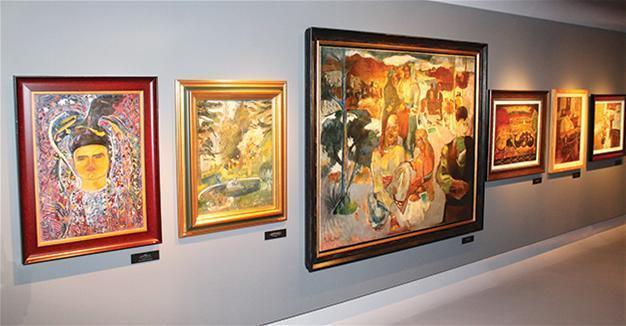Love at the heart of Bedri Rahmi expo in İzmir
Nazlan Ertan – İzmir

AA photo
“My black mulberry, my forked darky, my gypsy,What more will you be to me, my odd one, queer one,
My smiling quince, my weeping pomegranate,
My baby, my stallion, my wife.”
Turkey’s best-known love poem, “My Mulberry” by Bedri Rahmi Eyüboğlu, is at the heart of the retrospective exhibition by the poet-painter in İzmir’s Folkart Gallery.
The exhibition titled “To Love is a Beautiful Profession, Chief” brings together a wide variety of his works, as well as memorabilia of the painter-poet, known to the public simply as Bedri Rahmi, who recently marked the 106th anniversary of birth. He died of pancreatic cancer in 1975.
“Bedri Rahmi remains one of the best known painters and poets in Turkish art history simply because he was a man of the people,” said Fahri Özdemir, the director of the Folkart Gallery.
“He had great charisma and international renown. But he remained a man of the people and his cultural references and the motives of his works were essentially Anatolian, though of course he also learned a great deal from major artists with whom he worked,” Özdemir added.
The exhibition includes several of the “Mulberry” paintings, which are the portraits of the artist’s lover Mari Gerekmezyan. So is a bust of Bedri Rahmi by Gerekmezyan, a Turkish-Armenian artist who became one of Turkey’s first female sculptresses.
“Bedri Rahmi loved this woman with the dark mulberry eyes, wrote poems mentioning her and painted her portraits. When she became ill with tuberculosis, he sold several of his paintings for prices next to nothing to pay for her medical treatment. When she died suddenly in 1947, he must have been overtaken by his loss,” said Özdemir.
Bedri Rahmi’s famous poem “My Mulberry” was published in 1948, a year after the death of Mari Gerekmezyan. Many mistakenly believed that it was inspired by his wife and comrade-in-arts, Eren Eyüboğlu, a Romanian painter who Bedri Rahmi fell in love with in Paris in the 1930s. Eren Eyüboğlu knew that this was not the case and “her heart had been branded with a hot iron” when Bedri Rahmi recited the poem, as she said in a letter to her wayward husband.
Love first and last
Bedri Rahmi had been a pioneer in putting love and sensuality at the heart of his art, according to writer Ferit Edgü.
“Our art has been shy about love and our artists about nudity, the main subject of art, before 1950,” Edgü said. Women were often depicted working in the fields, fighting in a revolution, reading or pensively looking out the windows; but there were preciously little women figures naked, and even less making love.
Bedri Rahmi Eyüboğlu, fresh out of the Istanbul Fine Arts of Academy, joined the art world in France in the 1930s as a young man in love – in love with the world of colors and forms, in love with Romanian painter Ernestine with her “naughty eyes.” His ability to use cultural motives and learn from the international “masters” of painting impressed Andre Lhot, the hard-to-please Parisian teacher and writer of art. The Folkart exhibition includes a letter that expresses Lhote’s praise of the young Eyüboğlu.
“Eyüboğlu was a hard-working artist, who put 18 hours a day in his work. He travelled extensively, tried new forms of expression like a true Renaissance artist and worked very hard in bringing up young painters. Besides painting, he made world-renown murals, including one in NATO headquarters in Brussels, worked with stained glass and wood printing, made a documentary on the life of Turkish poet and singer Aşık Veysel. If there are a 15 Turkish artists who are known internationally, he is among the top ones,” Özdemir said.
The “To Love is a Beautiful Profession, Chief” exhibition, (named after a line from his poem “Poised to Go), can be visited until March 12 in İzmir. Its next stop will be Ankara’s CerModern.
















